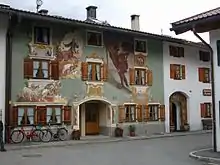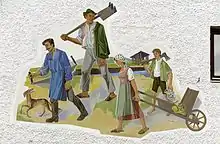Lüftlmalerei
Lüftlmalerei, (also spelt Lüftelmalerei) is a form of mural art that is native to villages and towns of southern Germany and Austria, especially in Upper Bavaria (Werdenfelser Land) and in the Tyrol.

Style

The origin of the term is disputed but may have come from the name of the home of façade artist, Franz Seraph Zwinck (1748–1792) of Oberammergau, Zum Lüftl.
Lüftlmalerei is a popular, folk-oriented variation of trompe-l'œil from the Baroque and imitates architectural elements. As in 'high architecture' it also embeds pictorial cartouches, mirrors and fields. Its subject matter ranges from the patron saints of houses or house emblems to representations of Biblical stories and the classical motifs of peasant art from everyday rural life to hunting. Banners with mottos are common and the sundial is also a popular element.
The paintings are applied to the fresh lime plaster using a fresco technique, whereby the colours silicify with the plaster in a chemical reaction and the paintings are thus able to survive for a long time. Today, other weatherproof painting materials are also used.
Architectural examples
 Rathaus portal at Lindau (Bodensee)
Rathaus portal at Lindau (Bodensee) Mittenwald, detail
Mittenwald, detail Mittenwald, Ballenhausgasse 12, Beim Gschdoaga
Mittenwald, Ballenhausgasse 12, Beim Gschdoaga Mittenwald, Obermarkt 45, Südtiroler Stubn
Mittenwald, Obermarkt 45, Südtiroler Stubn Neubeuern market place, county of Rosenheim
Neubeuern market place, county of Rosenheim Kiefersfelden, Bauernhaus
Kiefersfelden, Bauernhaus Samerberg, Bauernhaus
Samerberg, Bauernhaus Garmisch-Partenkirchen, Zum Husaren
Garmisch-Partenkirchen, Zum Husaren Berchtesgaden, Hirschhaus
Berchtesgaden, Hirschhaus Feldkirchen in Kärnten, painting above the entrance of an old bakery
Feldkirchen in Kärnten, painting above the entrance of an old bakery Bad Liebenstein, Villa Feodora
Bad Liebenstein, Villa Feodora The Stettner House in Prien am Chiemsee, village of "Am Gries"
The Stettner House in Prien am Chiemsee, village of "Am Gries"
Literature
- Herbert Meider, Franz Stoltefaut: Lüftlmalerei an Isar, Partnach, Loisach und Ammer. Medien-Verlag Schubert, 2003, ISBN 3929229927.
- Paul Ernst Rattelmüller: Lüftlmalerei in Oberbayern. Süddeutscher Verlag, München 1981.
External links
| Wikimedia Commons has media related to Lüftlmalerei. |
- Lüftlmalerei in Mittenwald (with numerous illustrations)
- Julia Ricker: Bilderbuchdörfer. Die hohe Kunst der Lüftlmalerei in Mittenwald und Oberammergau. In: Monumente Online, June 2016.